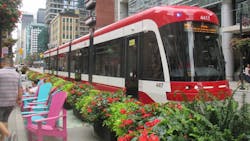City of Toronto seeing success on strategies taken to improve traffic flow and safety along King Street Transit Priority Corridor
The city of Toronto has seen success on traffic management strategies the city took in December 2023 to improve traffic flow and safety along the King Street Transit Priority Corridor.
The strategies include the deployment of dedicated Traffic Agents at the intersections of King Street and University Avenue, York Street, Bay Street, Yonge Street, Church Street and Jarvis Street on weekdays during peak traffic periods.
Reduced travel times
The city of Toronto notes that when Traffic Agents are present along the King Street Transit Priority Corridor, streetcar travel times between University Avenue and Jarvis Street are approximately 28 to 44 minutes faster (45 to 65 minutes total journey time reduced to 17 to 21 minutes total journey time).
Traffic Agents are empowered to manage traffic at intersections by dynamically directing road users in real-time, enforcing transit priority and restricting motor traffic at most intersections along the King Street Transit Priority Corridor, with exceptions for local access. The city of Toronto says the actions of Traffic Agents are supported by Toronto Police Service officers, who work with Traffic Agents to enforce traffic violations at intersections along King Street.
The city of Toronto will continue to deploy Traffic Agents along the King Street Transit Priority Corridor as needed to manage evolving traffic demands, reduce congestion and ensure safety for all road users.
Additional measures
The city of Toronto has implemented several other traffic management enhancements along the King Street Transit Priority Corridor, including:
- Modifying traffic signal timings to give streetcars more time to travel through intersections.
- Adding dedicated transit signals to reduce the likelihood of motorists accidentally making an illegal movement, such as running a red light during a green transit signal, as well as improving signage and road markings.
- By mid-2024, temporary Toronto Transit Commission (TTC) platforms will be installed at 20 locations along King Street. The platforms will increase safety and help transit riders enter and exit streetcars more easily.
The King Street Transit Priority Corridor
King Street is TTC’s busiest surface transit route in the city, moving more than 72,000 riders on an average weekday.
The King Street Transit Pilot launched in 2017. In 2019, the city of Toronto’s City Council made King Street a permanent Transit Priority Corridor, giving priority to street cars and restricting motor traffic at most intersections, with exceptions for local access.
“Saving up to 40 minutes on your commute is no small feat. We’re committed to ensuring all Torontonians have a safer, more efficient journey, which is why we’re implementing smart traffic management strategies, speeding up public transit and investing in infrastructure projects that will get our city back on track,” said City of Toronto Mayor Olivia Chow.
“Fast, reliable transit is crucial to reducing traffic congestion, connecting our communities and making Toronto accessible for all. I’m pleased to see the positive results of the city’s traffic management strategies and look forward to our rollout of further transit enhancements,” said City of Toronto Deputy Mayor Ausma Malik.
